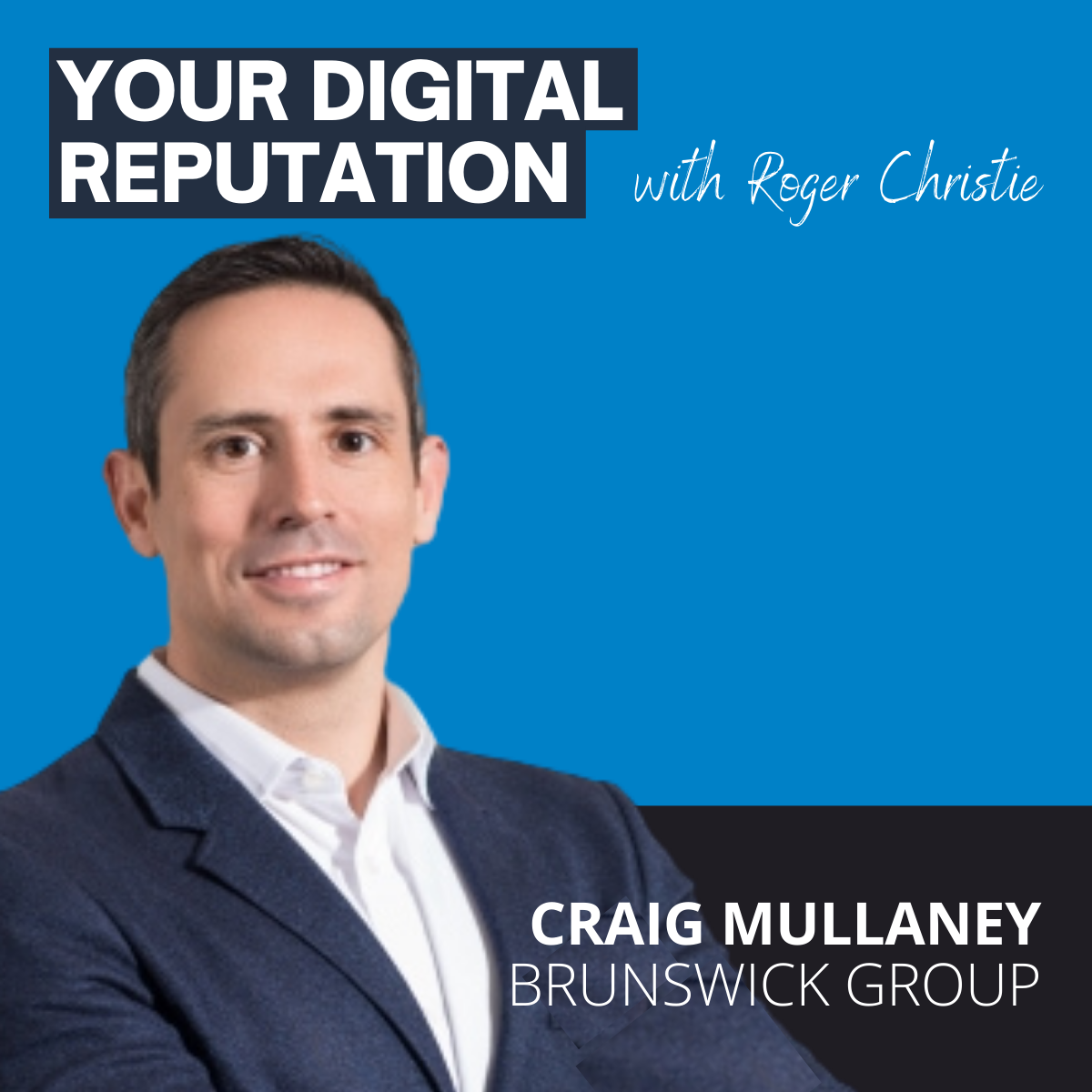In this episode of the Your Digital Reputation podcast, we have a slightly different interview for you. One that is essential for anyone who needs evidence and examples to get their leaders online.
Earlier this year, I joined Craig Mullaney, partner at Brunswick Group for the IABC World Conference. We joined forces to talk about an emerging trend we’d observed from different sides of the world, where multiple leaders, both within and beyond their organisational boundaries, appeared to be working in partnership online. Strange. Why would that be doing that? What added benefits could working together offer leaders that they just couldn’t access on their own? Why were leaders, even leaders from competing organisations, backing one another up in their posts on LinkedIn or Twitter? What could be gained by having multiple voices online, rather than just the one digital hero? The session was titled, ‘Going far together: How leaders can work together digitally to inspire a global audience.”
It was an absolute pleasure chatting with Craig, who I hold in such high regard on this topic. Here’s a snapshot from our chat.
Roger Christie (RC): For context, I first came across Craig many years ago during his time at Facebook where he interviewed ANZ Bank’s CEO, Shayne Elliot about his work as a social CEO. After Facebook, he then joined Brunswick as a partner in 2018. I can vividly remember an interview he did shortly after joining. He used this phrase that has been so central to the idea of leaders stepping up online that it still sticks with me today. He said, “You can’t follow someone you don’t trust and you can’t trust someone you don’t know.” This is the business case for getting executives online.
Since then, Craig has carved out a reputation for being one of the global authorities for executive use of social media. His perspective and experience is one that all Australian leaders and advisors should take note of, along with Brunswick’s Connected Leadership Report and Digital Investor Survey which provides incredible insight around the case for getting leaders online and the benefits they stand to gain when they do.
Craig Mullaney (CM): For three years now, Brunswick Group has published our annual Connected Leadership Report. We look at two main audiences – financial readers who regularly engage with top tier financial media; and employees of large companies – and ask them their expectations of leaders in today’s world.
What we have found consistently over three years, and really a trend that’s accelerated in the past two in response to the pandemic, is that it has now become a baseline expectation that leaders of any organisation must be online .
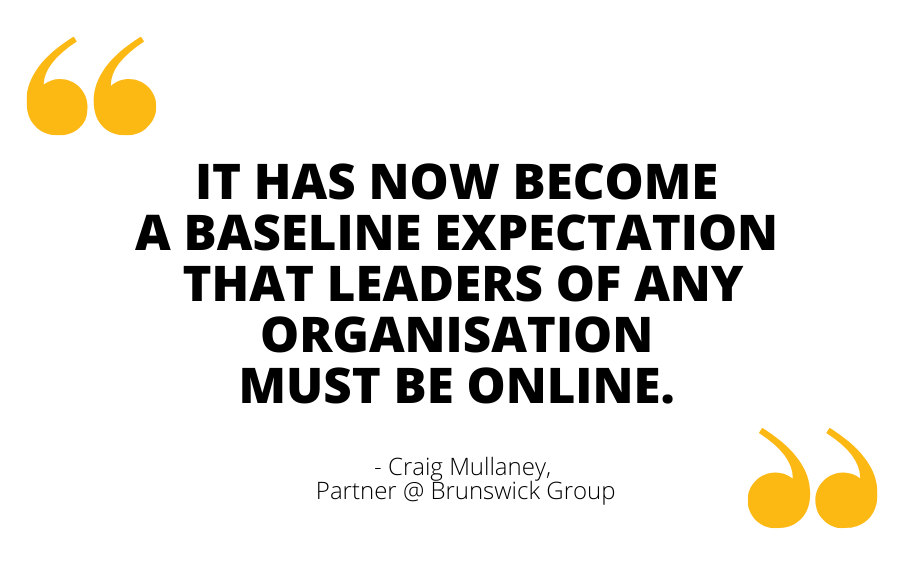
This corresponds with what we understand intuitively and anecdotally that leadership is never more important than in moments of crisis. That’s when we look to leaders. And due to the particular nature of this crisis, in most cases, leaders can’t be seen in 3D. Digital has become a proxy channel for financial readers and employee audiences to connect with businesses.
So now, turning to some of the key findings from the 2022 Report – we found amongst those audiences, and in seven markets globally, that:


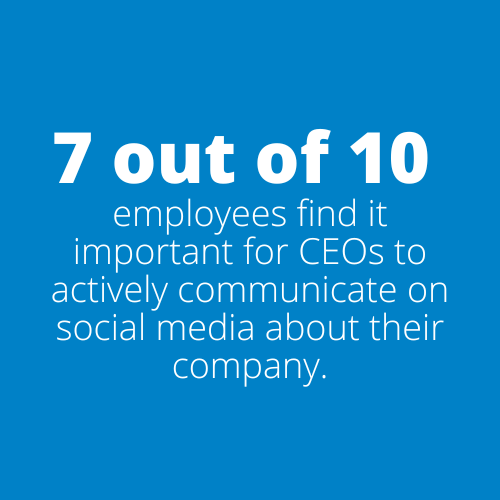
All of which is to say that in a world of hybrid work, in a world where there’s an increasing demand on talent, and that war for talent has never been fiercer, this is a competitive advantage that a company just can’t choose to operate without, without using that leverage. It’s important for building trust and these audiences trust a connected leader more than a leader who’s not using social media to engage stakeholders.
RC: Social media is really powerful stuff. And it’s not all talking either. Some of the CEOs featured in the report also highlight the value of using social media to listen.
CM: Absolutely. And that is the power of social media. It’s not purely a broadcast mechanism. It’s a two way street. Leaders are able to use that on demand; a globally scalable focus group, if you will, for a CEO to hear from employees at all levels within the organisation.
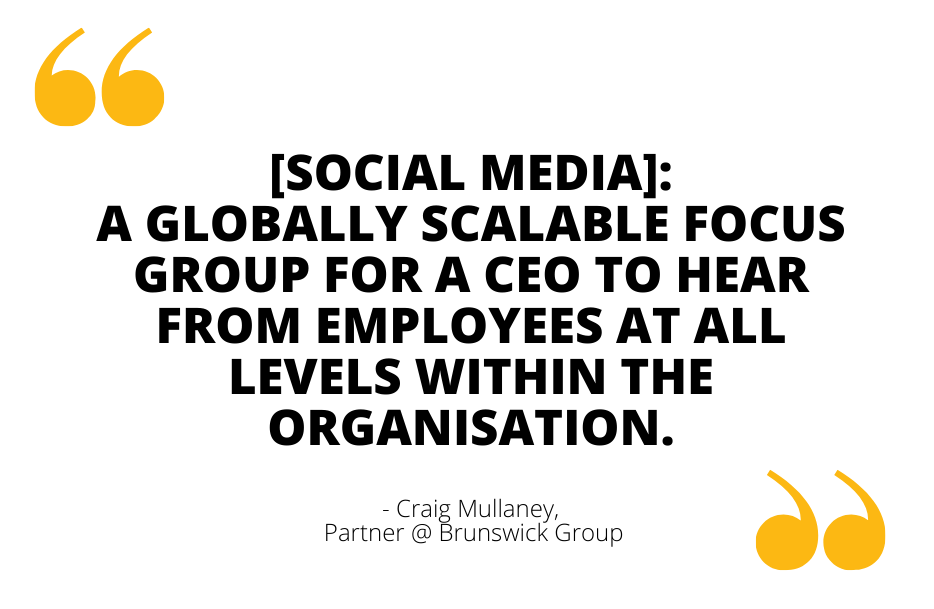
RC: An on-demand, globally scalable focus group to hear from employees at all levels – let’s just think about that for a moment. It sounds like an intelligence source any leader would relish, especially right now – to hear the heartbeat of organisational culture. This idea of the ‘listening leader’ is dramatically different to the ‘digital hero’ concept many have become accustomed to seeing online. The ‘digital hero’ approach where organisations invest all their time and energy into ensuring the one central leader is seen and heard everywhere.
And I think this is getting to the core of the challenge for organisations. When leaders take a ‘me’ vs a ‘we’ approach to social media, that’s when they lose. That’s when they miss key conversations and collaborations and – strangely – invite far more risk and reputational damage. According to Craig’s research, the leading CEOs online – globally – are the ones who recognise a few core principles:

Having a social media presence is essential for any leader who wants to attract. An effective social media presence involves far more than broadcasting media releases or shouting from the soapbox – listening and engagement are vital.

Going into social media with a ‘we’ vs a ‘me’ mindset, and intentionally working with others online, is the fastest way to succeed. And THIS is the trend we’re seeing among the most successful leaders online.
I’m talking about a digital coalition – or digital choir as I know Craig refers to it. A ‘digital coalition’ is a group of leaders working together as individuals online to achieve mutually beneficial outcomes. This may be a leadership team using LinkedIn to engage diverse stakeholder groups to achieve strategic diversity and inclusion targets, but it can also be leaders from different organisations combining their voices on key social issues (you can read more about it here in my mini series on the topic: part one + part two).
Either way, the effect of a successful digital coalition is both immediate in terms of performance and amplification of messages. But it’s also enduring, as the example set by leaders has a trickle down effect, empowering those workforces under their leadership to follow suit. This unlocks a diversity and depth of online voices that creates the best talent attraction and reputation management capability in the modern age.
So, if you’re on a board listening to this and anxious about investing in your CEO’s social media profile because of Key Person Risk – or the ‘Alex Malley Effect’ for those who remember what happened with him and the CPA here in Australia just a few years ago – this idea of a digital coalition should be music to your ears. Not only does it protect the organisation – it taps into the very elements of social networks that make crucial, positive messages spread like wildfire. How does it work? Well, let’s quickly unpack a few common scenarios that bring it to life.
Let’s say you’re trying to encourage staff back into the workplace, or teams are feeling disengaged due to COVID disruptions. When trying to understand the needs of employees and other stakeholders online, how much more informed would a leadership team be – how much more connected to stakeholder needs would they be – if they were all listening to the views and attitudes of those audiences relevant to them? Not one line in, one line out, but a range of leaders sharing insights and experienced from across the stakeholder spectrum in real time? How much better would decision making be? All that can be done most effectively – at scale – online.
Another scenario – perhaps equally common right now. You’re trying to attract talent amid record unemployment and labour shortages. How are you doing it? By sharing links to job ads on SEEK or LinkedIn? What if your leadership team all had established profiles online, and could not only share specific opportunities when they come up in a personal, meaningful way, relevant to their networks. And in doing so, turning generic job ads into invaluable advocacy opportunities for staff and partners who endorse your organisation publicly. If that’s not good enough – and that’s pretty good! – what if every single post your leaders did, diverse in thought, in tone, in focus areas, reflected their values and resonated so much with people they were compelled to reach out BEFORE a job ad even hit the market?”
Finally, a very straightforward one. One leader on their own in the digital world simply invites far too much risk. Whenever you have a key message to get out, it can only go through the one leader’s channel. They quickly become a bottleneck. Whenever you have a diverse range of messages to get out, on key social issues or things that relate to a specific function of the organisation, they can only go through the one leader’s channel. Those messages quickly become inauthentic. And when that leader leaves, as all leaders do, all that profile, all that equity, all that goodwill simply walks out the door with them. And you’re starting again from scratch. Why put your organisation in that position – why put all your eggs in the one basket. That is the power of the digital coalition. That is the power of getting your leaders – and more – active online.
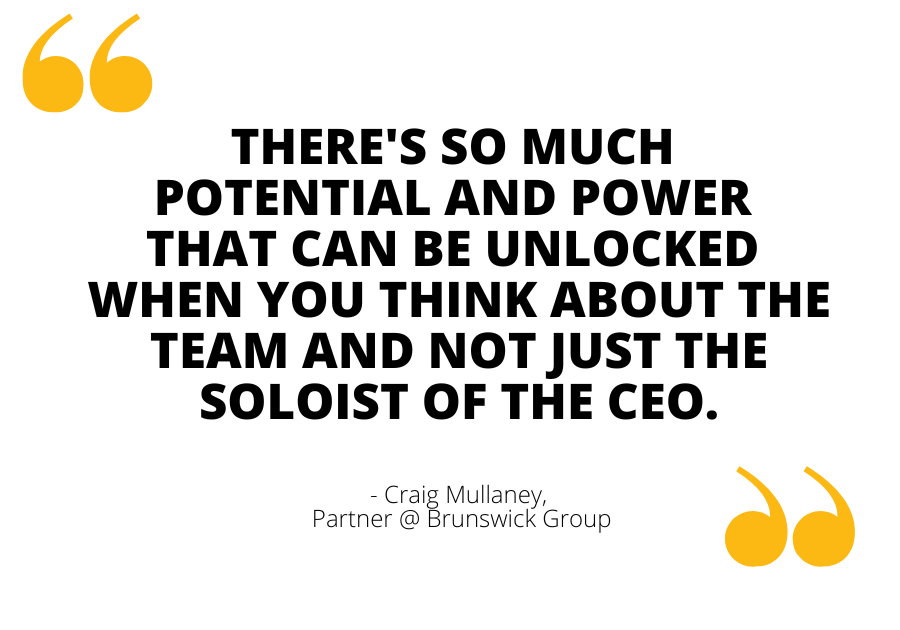
CM: In almost every company I’ve advised, at this point it is probably north of 400 or 500 business leaders, you start typically with the CEO who’s willing to take a risk and be president on social media. And the team behind that CEO masters it within a couple of years and they ask, “What’s next?” They see that the real opportunity lies in the limitations of having just one voice representing the company externally.
They look around and say, “We have an amazing cast of characters around the CEO.” Whether it’s the Chief Technology Officer or the Head of Human Resources. Maybe there’s an heir apparent, the COO or a president within the company. And then they’re getting to the next level of complexity, which is how do you bring together all of those leaders? How do you turn them all into assets for the company while recognising that there needs to be one melody from the company, a particular story and narrative that needs to be told at that moment in time, while using each of those voice parts in a way that gives you real harmony, that engages different audiences. It may be that the person investors are most interested in hearing from is the CFO? It may be that talent is more receptive to hearing about the company’s pioneering benefit offer from the Head of Human Resources? Or an engineer is interested in hearing about the cutting edge technologies the company is employing from the CTO.
That takes significant work on the strategy, training and synchronization of operations and that’s often where consultants like you and I get called in to help a company figure that out. But there’s so much potential and power that can be unlocked when you think about the team and not just the soloist of the CEO.
There’s so much potential and power that can be unlocked when you think about the team and not just the soloist of the CEO.
